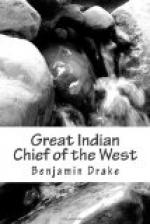“This arrangement had scarcely been concluded, before a flagrant outrage was committed, by a party of these Indians, upon a band of friendly Menomomies, almost under the guns of Fort Crawford. Twenty-five persons were wantonly murdered, and many wounded, while encamped in the Prairie du Chien, and resting in fancied security upon our soil, and under our flag. If an act like this, had been suffered to pass unnoticed and unpunished, a war between these tribes would have been the consequence, in which our frontiers would have been involved, and the character and influence of the government, would have been lost in the opinion of the Indians.
“Apprehensive, from the course of events already stated, and from other circumstances, that the disaffected band of Sacs and Foxes, would again harass and disturb the settlements upon our borders, and determined that the murderers of the Menomenies should be surrendered or taken, the department ordered General Atkinson, on the 7th of March last, to ascend the Mississippi with the disposable regular troops at Jefferson barracks, and to carry into effect the instructions issued by your direction. Still further to strengthen the frontiers, orders were given for the re-occupation of Chicago.
“The demand for the surrender of the Menomenie murderers was entirely disregarded: and the British party of the Sacs and Foxes recrossed the Mississippi, and assuming a hostile attitude, established themselves upon Rock river. The subsequent events are well known, and the result has already been stated in this report.”
In the annual report of Maj. General Macomb to Congress, of November 1832, very much the same positions are taken in regard to the causes which led to this contest with the Indians, that are contained in the report from the War Department. Its leading object seems to be to place the United States in the right—the Indians in the wrong.
It is to be regretted that the Honorable Secretary, whose opinions and statements on all subjects connected with the Indians, carry with them great weight, had not been more explicit, in assigning the causes which led to the late war, with a portion of the Sacs and Foxes. It is not to be supposed that the Secretary would designedly omit any thing, which in his opinion, was necessary, to a fair presentation of this matter; but as the case stands, his statement does not, it is believed, do justice to the Indians. The Secretary says the Sacs and Foxes “have always been discontented, keeping the frontier in alarm, and continually committing some outrage on the persons or property of the inhabitants.” Between the treaty of peace at Portage des Sioux, in 1816, and the attack of Major Stillman, in 1832, it is supposed that the Sacs and Foxes never killed one American; and, their aggressions upon the persons and property of the whites, consisted principally, in an attempt to retain possession of their village and corn-fields, when pressed upon by the white settlers,




